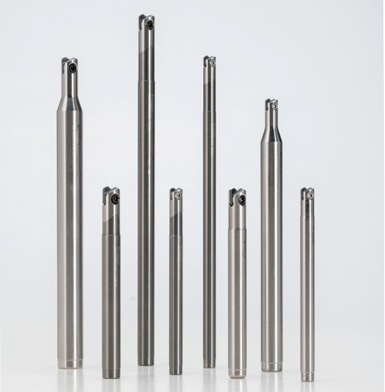High-Feed Performance for Mold and Die Machining Operations
The Ingersoll NanoFeed indexable insert’s applicability for detailed, high-feed rest roughing operations offers mold builders optimized milling performance for miniature components and smaller part features.

Photo Credit: Ingersoll Cutting Tools
Ingersoll’s new NanoFeed technology provides mold builders with exceptional high-feed milling performance for machining of miniature components and smaller part features.
NanoFeed is a 20-degree high-feed indexable insert design that Ingersoll claims will replace smaller diameter solid carbide end mills in a variety of applications. Inserts have been designed with pressed-in coolant channels, directing coolant or air directly to the cutting edge for maximized tool life. Inserts also have backdraft side clearance for straight-wall milling capabilities. Available in 6-mm and 8-mm diameters with steel or carbide shank options, NanoFeed will reportedly reduce cycle times, increase productivity and help to reduce solid carbide usage.
Furthermore, this highly engineered high-feed insert geometry is free cutting, providing excellent stability when in the cut. This is due to a strong and precise offset v-notch clamping system that firmly secures the high-feed insert in the pocket. Increased feed rates along with increased productivity are said to be achieved from the 3X times feed rate multiplier offered with this design. These faster feed rates combined with smaller cutter diameters will enhance many smaller detail roughing operations.
Particularly useful will be the benefits provided when performing detailed, high-feed rest roughing operations, which are a commonly used programing technique in the mold and die industry. Dies and molds of different sizes often have smaller detailed part feature areas that require various types of CAM programming pick-out roughing routines to bring the part in to net-shape prior to finishing. These routines can utilize different types of milling tools as well. Small diameter indexable end mills are a good option when milling these types of details. This is one industry-specific example of where the NanoFeed can offer significant process improvement, whether it’s for high-feed face, contour, shoulder, slot, corkscrew and ramp machining.
Related Content
-
Solving Mold Alignment Problems with the Right Alignment Lock
Correct alignment lock selection can reduce maintenance costs and molding downtime, as well as increase part quality over the mold’s entire life.
-
Advantages and Disadvantages of Copper and Graphite Electrodes
Both copper and graphite provide approximately the same end result, so it is important for a shop to consider the advantages and disadvantages of each material in order to discover what would work best in their shop floor environment.
-
How to Eliminate Chatter
Here are techniques commonly used to combat chatter and guidelines to establish a foundation for optimizing the moldmaking process.
.png;maxWidth=970;quality=90)





.jpg;maxWidth=300;quality=90)






.jpg;maxWidth=970;quality=90)